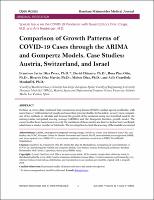Por favor, use este identificador para citar o enlazar este ítem:
https://repositorio.usj.es/handle/123456789/505
Registro completo de metadatos
| Campo DC | Valor | Lengua/Idioma |
|---|---|---|
| dc.contributor.author | Díaz Pérez, F. J. | - |
| dc.contributor.author | Chinarro Vadillo, David | - |
| dc.contributor.author | Pino Otín, Rosa | - |
| dc.contributor.author | Díaz Martín, Ricardo | - |
| dc.contributor.author | Diaz, Moises | - |
| dc.contributor.author | Guardiola Mouhaffel, Ali Adib | - |
| dc.date.accessioned | 2021-03-01T12:20:42Z | - |
| dc.date.available | 2021-03-01T12:20:42Z | - |
| dc.date.issued | 2020-07 | - |
| dc.identifier.citation | Diaz Perez FJ, Chinarro D, Otin RP, Martín RD, Diaz M, Mouhaffel AG. Comparison of Growth Patterns of COVID-19 Cases through the ARIMA and Gompertz Models. Case Studies: Austria, Switzerland, and Israel. Rambam Maimonides Med J 2020;11 (3):e0022. doi:10.5041/RMMJ.10413 | es_ES |
| dc.identifier.issn | 2076-9172 | es_ES |
| dc.identifier.uri | https://repositorio.usj.es/handle/123456789/505 | - |
| dc.description.abstract | On May 19, 2020, data confirmed that coronavirus 2019 disease (COVID-19) had spread worldwide, with more than 4.7 million infected people and more than 316,000 deaths. In this article, we carry out a compari-son of the methods to calculate and forecast the growth of the pandemic using two statistical models: the autoregressive integrated moving average (ARIMA) and the Gompertz function growth model. The countries that have been chosen to verify the usefulness of these models are Austria, Switzerland, and Israel, which have a similar number of habitants. The investigation to check the accuracy of the models was carried out using data on confirmed, non-asymptomatic cases and confirmed deaths from the period February 21–May 19, 2020. We use the root mean squared error (RMSE), the mean absolute percentage error (MAPE), and the regression coefficient index R2to check the accuracy of the models. The experimental results provide promising adjustment errors for both models (R2>0.99), with the ARIMA model being the best for infections and the Gompertz best for mortality. It has also been verified that countries are affected differently, which may be due to external factors that are difficult to measure quantitatively. These models provide a fast and effective system to check the growth of pandemics that can be useful for health systems and politicians so that appropriate measures are taken and countries’ health care systems do not collapse. | es_ES |
| dc.format.extent | 13 p. | es_ES |
| dc.format.mimetype | application/pdf | es_ES |
| dc.language.iso | eng | es_ES |
| dc.publisher | RAMBAM HEALTH CARE CAMPUS | es_ES |
| dc.rights | Atribución 4.0 Internacional | * |
| dc.rights.uri | http://creativecommons.org/licenses/by/4.0/ | * |
| dc.subject | ARIMA | es_ES |
| dc.subject | Coronavirus | es_ES |
| dc.subject | COVID-19 | es_ES |
| dc.subject | Gompertz | es_ES |
| dc.subject | Growth model | es_ES |
| dc.title | Comparison of Growth Patterns of COVID-19 Cases through the ARIMA and Gompertz Models. Case Studies: Austria, Switzerland, and Israel | es_ES |
| dc.type | info:eu-repo/semantics/article | es_ES |
| dc.identifier.doi | 10.5041/RMMJ.10413 | es_ES |
| dc.rights.accessrights | info:eu-repo/semantics/openAccess | es_ES |
| Aparece en las colecciones: | Artículos de revistas | |
Ficheros en este ítem:
| Fichero | Descripción | Tamaño | Formato | |
|---|---|---|---|---|
| Comparison of Growth Patternsof COVID-19 Cases through the ARIMA and Gompertz Models..pdf | 1,22 MB | Adobe PDF |  Visualizar/Abrir |
Este ítem está sujeto a una licencia Creative Commons Licencia Creative Commons

